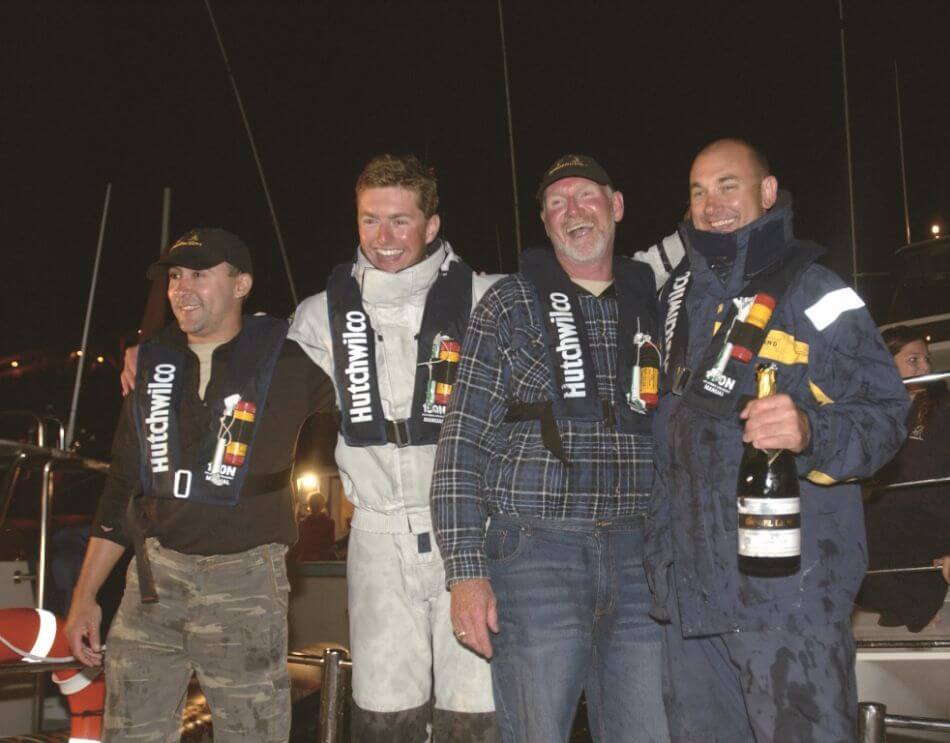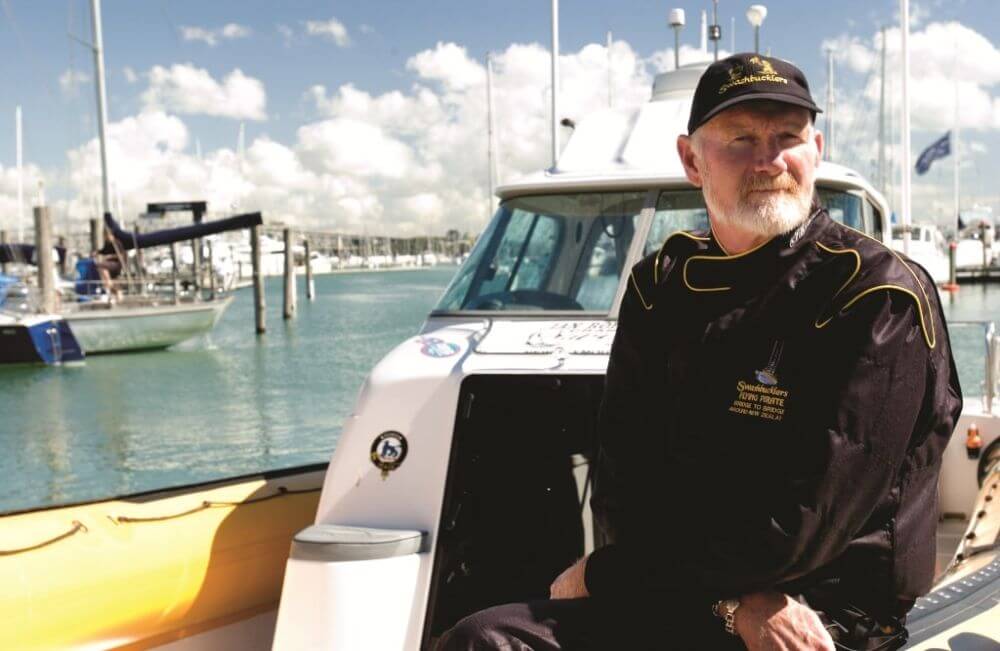Text by Barry Thompson
There’s a small plaque above the companionway leading to the cabin on Ginger Gibbs boat, Swashbucklers that says…A man can not discover new oceans, unless he has the courage to lose sight of the shore. Never was a statement more apt than for Ginger and his band of adventurers who took on an unpredictable and unforgiving Tasman Sea in a diminutive powerboat to break a 45 year old, 47.5 hour record held by an ocean liner 20 times their boat’s length.
Restaurateur, fisherman, adventurer – Ginger Gibbs is all of the above and more. A man possessed by a passion to go beyond the boundaries to achieve goals that others only talk about.
Three years ago Ginger decided that he wanted to cross the Tasman on the water, from Sydney to Auckland, faster than anyone ever had. Some research soon discovered that while there had been commercial boats that had run some fast times from Australia to New Plymouth, Wellington and even Bluff, none had been recognised as true records.
“We did a lot of research and came up with an actual documented record time from Sydney Heads to Auckland’s Rangitoto Lighthouse. The earliest recorded time was back in 1937 by the 166m SS Awatea – 2 days 7 hours 28 minutes and the latest, in 1961 by the cruise ship Oriana.” said Ginger
That record that has stood for almost half a century formed the basis of the record attempt, but Ginger wanted to add something of his own so he extended the run by 7nm by making it Sydney Harbour Bridge to Auckland Harbour Bridge. To make sure everything was official he had the event timed by the UIM (Union of International Motorboating), the world governing body on powerboat racing and records.
“We knew that there would be people coming out of the woodwork after, who claimed they had done the crossing quicker, but no-one had covered the same ground we did and had it officially recorded”.
“Claim what you like, but unless it is timed by independent officials it ain’t worth shit”!
Having the right boat for such an arduous crossing would be paramount to the success of the mission and although initial talks went as far as a radically designed 30m wave piercing ultra light displacement trihull, the final choice was simple yet effective.
Swashbucklers started out as a stock standard Rayglass 12m Protector with very little altered to the standard boat. Construction was overseen in all areas to make it ‘Ginger proof” and some modifications were made to the underwater running plank by adding a section of V to make the hull a little softer riding in the big seas.
Engines were a major consideration and the decision to run a pair of standard Volvo Penta D6 diesels coupled to Volvo DPS legs was viewed by many as being the wrong choice. Even Volvo Penta themselves were not keen for Ginger to run their engines at 90% of their power for better than 30 hours. Man, how wrong they were! Top speed during trials on Auckland Harbour with 1000 litres of fuel was 46.9 knots with D7 propellers, which gave a 134 litres total fuel usage per hour. D8’s gave 49 knots but the fuel usage increased to 147 litres per hour, reflecting the fact that the engines were being asked to work harder at the higher speed.

“We had faith in the engines, and while some people said we should be running jets or surface drives, I felt the beefed up Volvo twin prop drives would do the business and last the distance without any problems.” he added. Ginger was to be proved 100% right.
About three weeks after launching, the big yellow Swashbucklers was shipped to Australia, where Ginger carried out a waiting came with the weather. While a definite date had not been set, Ginger had two reasons for leaving Sydney when he did.
The first was the mid Tasman rendezvous with his brother Shag, in his 20m fishing trawler, Savannah, to take on fuel and the second was that he simply wanted to get back midday of the last day of the Auckland Boat Show. Unfortunately that would not happen.
“My brother had a timetable to keep back in New Zealand and if we didn’t make the fuel stop meet within the time frame, he would have had to leave and we would have had to abort the attempt and return home by air, which wasn’t an option as far as I was concerned”.
As it was, Savannah had already been out at sea for 10 days in atrocious sea conditions, so Ginger had to make the call to go. “The trade-off was it was going to be slightly bad weather leaving Sydney, average in the mid Tasman and maybe a rough patch around Cape Reinga, but with the hope of a smooth run down the Northland coast”.
Trials in Auckland prior to shipping revealed a few small problems, all of which were sorted out before the boat was shipped to Sydney. However, even during tests a few days prior to the record attempt things started to go wrong and these put great strain on the programme.

Steering issues during tests on Sydney harbour dogged them all the way back to Auckland, but if that was the worst to happen, Ginger didn’t really care. There were 1278 nautical miles of open water ahead, and a forecast that predicted weather that was more suitable for maxi yachts than a 12.5m RIB.
Big Seas, Big Water, Big Balls!
At 6:00am on March 10, Ginger and his hand picked crew of Adam Wickes (Rayglass Boats), Paul Ricks (Volvo Penta) and Daniel Hedges (Team New Zealand) roared under Sydney Harbour Bridge at 42.5 knots and headed in flat calm water for Sydney Heads. That was to be almost the last stretch of calm seas the team would encounter all the way to Auckland.
Leaving Sydney, Swashbucklers went straight into a 25knot SE with 5m seas that within 5 hours changed to a 25knot NW with heavy rain and a short, sharp 3m sea.
Leaving Sydney Heads with a full load of fuel (2600 litres), they maintained 36 knots and as the boat used the fuel it got lighter and slightly quicker, but it was not a pleasant ride in the NW swell and the boat and crew were knocked around. It was not until they were 12 hours into their journey that the seas abated. “We had a beautiful trip through the night with calm seas and ideal conditions that allowed us to maintain a high average speed for long periods.”
However, the 10 hours of rough seas prior had taken its toll on the fuel usage and so some recalculations were necessary if they were to make the ocean fuel stop rendezvous. The result was the fuel boat moving station 50 nautical miles further west and Swashbucklers slowing to 36.5 knots to conserve fuel.
Two spare sets of propellers were carried aboard and while plans were to change them in mid ocean as the fuel load decreased, sea conditions didn’t allow it and the result was a higher fuel usage than anticipated.
At 8.30 am, 300 nautical miles west of Cape Reinga they met Savannah, with just 50 litres of fuel left in the tanks. The fuel stop went off without a hitch and within 7min, 2000 litres had been transferred through a 38mm diameter hose with the help of a high capacity fuel pump kindly loaned for the record run by General Marine Services.

“Within 10 minutes of throwing the ropes off we were over the horizon and out of sight of Savannah. Even with the heavy fuel load we were able to push the boat to the max in the light conditions and ran upwards of 41 knots and at that stage I still felt confident of cracking a 33 hour or maybe even a 32 hour time for the record”.
However, once again the weather had the last call and within an hour of leaving the fuel boat the edge of a southerly was reached. Within a short time Swashbucklers was running in an easterly direction through a 25knot SE weather pattern that came uncomfortably at them on the forward quarter.
Only 200 nautical miles off Cape Reinga, the Swashbucklers team were experiencing the worst weather of the trip so far. The rubbers had popped out around the side windows and water was coming in through the starboard window. Then 100 nautical miles off the coast a big wave wiped off the radar arch, complete with all the navigation domes. With no GPS, radar or sat-compass the crew were forced to manually steer the boat until Adam Wicks jury-rigged another autocompass.
“Despite not having any electronics I was now in very familiar territory so I felt comfortable and could have steered the boat all the way back to Auckland if necessary.” says Ginger.
At Cape Reinga the wind strength had risen to 50 knots and they had dropped Swashbucklers speed to 28 knots. It was about then that Adam spotted a twin engine aircraft, their first contact with supporters from Auckland.
“Seeing Glen and Peter Urquhart above us was really neat and gave us all a lot of encouragement, knowing that people back home were right behind us”.
As Swashbucklers rounded Cape Reinga on dusk, conditions got ugly and they reduced speed to 25 knots. Rounding the Cape close to shore there was a little respite from the rough seas until 7.30 pm when they ran head on into a 25knot SE which almost stopped them dead.
“At this stage we had to stop to fix our faulty steering and in fact for the whole run down the coast we had little steering, but we were able to maintain a good pace all the way from the Cape to the Hauraki Gulf.”
Apart from the steering, Swashbucklers encountered few on-board problems. The drives and engines according to Ginger were one of the most outstanding features of the trip “There was never even a hint of a problem and even though we ran them at 90% of their capacity they sung sweet music all the way.”
At 2:45am, 40 hrs 31min 26secs after leaving Sydney Harbour Bridge, Swashbucklers crossed under the Auckland Harbour Bridge and established two new records. It had taken 4100 litres of fuel, a whole load of guts and determination and a superbly efficient crew who were content to survive on muesli bars and water for almost two days!
And would Ginger do it again?
“It was harder than I expected, with sea conditions more extreme than I thought they would be, so no, not immediately. But if I was to do another challenge I would look at a larger 15m version of the same boat and maybe a couple of 600hp D9 Volvo engines through Q-SPD surface drives and two-speed ZF gearboxes. However, right now I’ll just wait. See if anyone breaks the record and then ask me again.”




